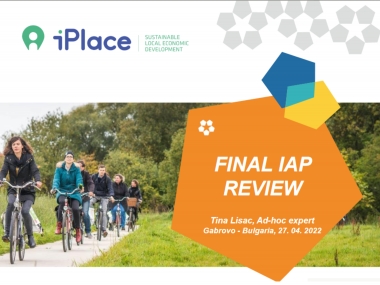Inspiring Actions I found in the iPlace IAPs
Edited on
23 August 2022URBACTs projects are always inspiring and one of the most important elements are that cities are learning from each other and inspiring new initiatives and ideas. Using URBACTs’ unique methodology ensures cities a more integrated, inclusive, and sustainable urban development with its well-designed and efficient tools.

In the URBACT iPlace project led by city of Amarante, Portugal and project partners from 9 other European cities: Balbriggan (Ireland), Gabrovo (Bulgaria), Grosseto (Italy), Heerlen (Netherlands), Kočevje (Slovenia), Medina del Campo (Spain), Pärnu (Estonia), Pori (Finland) and Saldus (Latvia), they have made quite a journey which resulted in new initiatives in their cities and with developing Integrated Action Plans (IAP) for each partner.
At a project partners meeting in Gabrovo, Bulgaria on 27th and 28th April 2022 final reviews on the IAPs were given. To explain, Integrated Action Plan is an instrument that can be used to plan concrete actions to respond to a policy challenge in a city. One of the main things while working on the IAP is the process itself and the IAP itself should be a result of participative process. With the participation of identified stakeholders city will get an important insight of the real needs and possibilities on a local level which helps to design useful and concrete actions which are more likely to be successfully implemented because of co-production.
Through the workshop in Gabrovo we tried to identify where IAPs could be improved. One of the basic things to make the IAP more understandable is to use clear structure and know who the audience is. Who will read the IAP and will the reader without previous knowledge about iPlace project know what is the point? Who participated and who is in the ULG and what is its role? It is important to show the use of participative process since the process itself is even more important than IAP for some cities.
All 10 cities made a great work presenting actions they planned, and we outlined important elements for every IAP in iPlace project to consider with showing the good practices from partners IAPs:
Good practices from project partners IAP can be found here.
- Form – it starts with a structure, but it is also useful to use some visual effects, explanations and design it properly. Is it easy to read?
- The identification of the strategic niche – how was the niche identified? Why this sector/niche? Supporting arguments for the chosen option are making it clearer.
- Description of the process – clearly showing the co-production of IAP. How was it done? Learnings and good practices identified through transnational exchange are also part of the process.
- Objectives, actions and schedule – using action table and results framework in the way that suits the city and actions planned, but it is necessary to keep it clear and readable.
- Expected results and result indicators –setting a goal, with exact indicators to monitor and clear vision what should be achieved is important to see if action planned was successfully implemented.
- Small Scale Actions (SSA) – apart from describing what was done it is good to consider the learnings from SSA. What did you want to test and what did you learn?
- Risk analysis – identification of the risks will help to understand the risks and plan the actions to mitigate risks.
- Enthusiasm and vision – keeping in mind that IAP will also be used to gain support and resources if needed. Clear vision and enthusiasm while keeping it realistic and well planned.
To make it easier to check the important elements we also used the IAP checklist, which is a simple tool to help everyone to keep in mind all the elements that could make IAP clearer, well written and planned.
It was inspiring to read the IAPs of 10 cities who are working together on the same project but at the same time they are having so many different ideas and good practices to share. It was especially good to see the enthusiasm they share to make the changes in their cities and how they are learning from each other. We used the same approach with the review to encourage transnational exchange while sharing the best practices from IAP from each city.
But while reading iPlace IAPs many inspiring actions were found. Sadly, all of them cannot be mentioned in one article. Most of Small Scale Actions (SSA) were not small and they gave cities an opportunity to test and learn while doing. One of inspiring actions to mention is My Green Week in Grosseto – week when they explored the city and possibilities in different seasons of the year. The SSA itself was not only helpful to gain important information about the offer and possibilities, but it also helped to confirm the choice of development niche. Beside applying the experiment in a complex and inspiring way, co-designing the SSA was one of the most important steps. Through the collaborative writing of a call for ideas for local stakeholders for the collection of sustainable and all year-round activities in the Grossetto area, they included members of ULG right from the start, giving them possibility to co-design and co-decide future steps. Including different active local actors in such initiatives gives more possibilities to make actions successfully implemented and attracting more people outside the group to collaborate. This step made it possible to engage a small group of people interested in sustainability and all year-round tourism in local area and include them in SSA Grosseto Green Week Travel Tour. Through a partnership with travel bloggers, they wanted to identify and narrate the experience of a Grosseto green week and while getting the important information, they also got ideas which activities to implement in the future. Travel bloggers having an opportunity to visit the activities and Grosseto gaining a series of textual, video, and visual content that can be used.
A bit different, more tech idea about Junior Coding School comes from Amarante, Portugal. They included it in their IAP and are planning it for a longer term, finishing in 2026. It aims to children from 6 to 12 years old and is creating a digital platform that teaches computer science and programming, using videos, games, and projects to challenge children.
It shows their understanding of importance of early education to prepare children for a digital society. School programs are still staying at the basic levels despise of quick development of digital society. Program like this will help children to prepare for digital society (including digital safety) and developing logical reasoning and problem-solving abilities. One of the main activities, and an important step for future changes, is raising awareness in Schools about the positive impact of
teaching computer programming on school performance and competences of young people. Next important activity is of course acquisition of the appropriate product for Schools.
At first sight it might be contradictive to make a platform that encourages children to use digital technology but applying programs as that will help to improve digital literacy and make the use of digital technology safer because of the knowledge. Other effects of such a platform will be visible later, since those are competences that will be even more necessary in future.
Those two inspiring actions shortly described were chosen not just because they are interesting, but also to showcase the inspiration that iPlace project gave to project partners. One action being ‘’green’’ and the other one completely ‘’tech’’ – and in iPlace project you can find the inspiration also for all in between. iPlace team is insightful, full of ideas and collaboration on a local and international level and with a clear aim – to make positive changes in their cities.
Written by Tina Lisac, URBACT Ad-hoc expert.
 Submitted by Sonia Files on
Submitted by Sonia Files on
